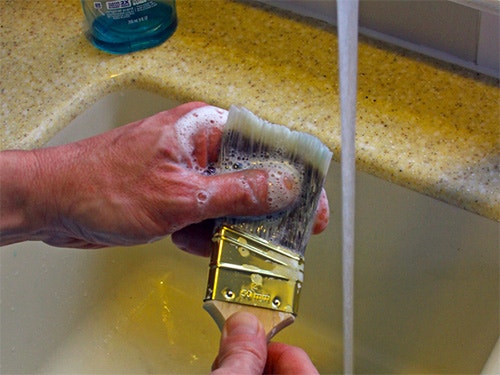Preventing Paint Build Up
How do I prevent the annoying buildup of very hard to clean, semi-dried paint in the heel of my paintbrushes? – Donald Matthews
Tim Inman: Pre-wet the brush with an appropriate solvent prior to use. This will help keep the paint from packing into the heel and drying hard. Then, after use —immediately after use! — clean the brush. Start by using a stick to rake out the excess paint. Lay the bristles down on a hard surface or countertop with lots of newspaper between the bristles and the countertop. Scrape from heel to tips of the bristles. This forces out excess paint. Then, wash thoroughly with solvent. Grab those bristles by their tips and push back towards the heel. Rotate to make sure all the bristles are open. Wash in solvent again. Put the handle between your palms and spin the brush to force out the excess cleaner and paint. (Do this by holding the spinning brush inside a trash can or 5-gallon waste bucket to avoid splattering all over the place.) Next, wash the brush with HOT water and soap. Do this several times, until the bristles smell like wet hair. Then, you'll know it is clean. Spin out the excess again. Wrap the brush in paper to help it dry in good form.
Synthetic bristles will not smell like wet hair. They are cleaned the same way, though. You should not be able to smell any solvent after a good clean wash and rinse! Your heels will be clean, too.
Chris Marshall: I hate to clean paintbrushes, but throwing them away after just a couple of uses is even more irritating. So, want them to last longer? Clean them more often, even if that means more fussing around during the painting process. After you paint for an hour or so, stop and clean the brush completely. It will wash out the semi-dry paint before it has a chance to harden up, and you’ll get "fresh" performance and flexibility from the bristles again. For latex and acrylic paints, I use a squirt of dish soap, massaged carefully through the bristles and rinsed clean. I repeat that process a couple of times, and the brush is ready for use again. Sure, it takes more work to clean the bristles more often, but here’s an ounce of prevention that's worth a pound of new brushes for me. Give it a try.
Keep the inspiration coming!
Subscribe to our newsletter for more woodworking tips and tricks




